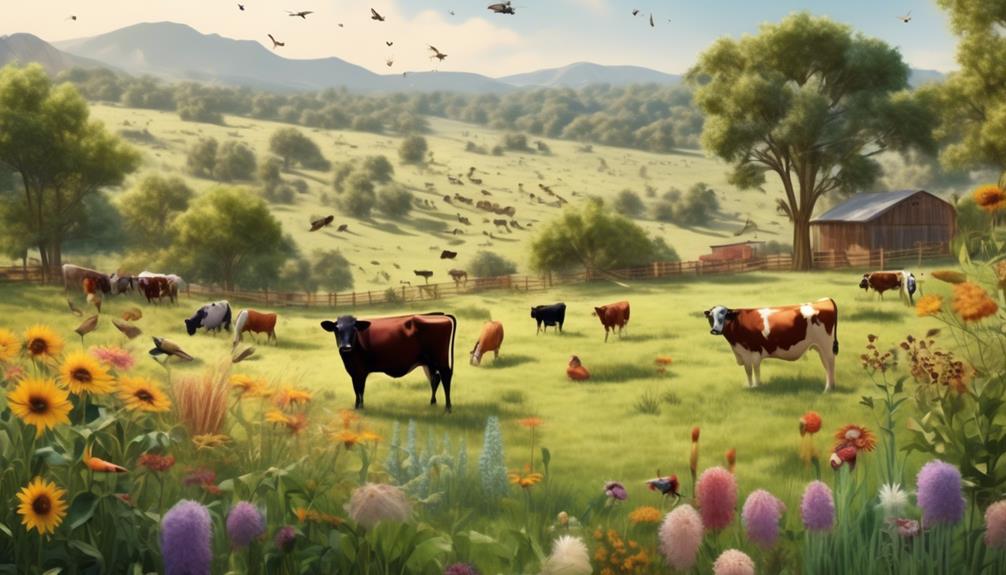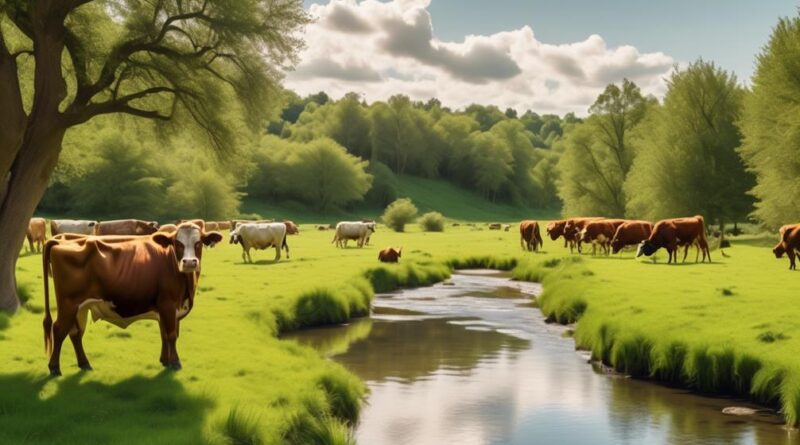14 Ways to Minimize Cattle Farming's Environmental Impact
So, you're all about that beef, huh? Well, let's talk about how you can still enjoy your steak without wreaking havoc on the environment.
Cattle farming has a significant environmental impact, but fear not, there are ways to minimize it. From sustainable grazing practices to climate-smart cattle feeding, we've got the lowdown on 14 strategies that can make a real difference.
But that's just the tip of the iceberg. Stay tuned to discover how simple changes in cattle farming practices can lead to a more sustainable future for both your burger and the planet.
Sustainable Grazing Practices
To minimize the environmental impact of cattle farming, implementing sustainable grazing practices is essential. By embracing regenerative agriculture and holistic management, you can significantly reduce the negative effects of cattle farming on the environment.
Regenerative agriculture focuses on restoring and enhancing the health of the land, while holistic management emphasizes planned grazing to mimic natural ecosystems.
When practicing regenerative agriculture, you can adopt rotational grazing methods. This involves moving cattle to different sections of the pasture in a planned manner, allowing the land to recover and regenerate. By doing so, you promote healthy soil, diverse plant life, and improved water retention.
Additionally, holistic management encourages you to consider the entire ecosystem when making grazing decisions. This approach emphasizes the importance of balancing the needs of the land, the livestock, and the people involved in the farming operation.
Furthermore, integrating trees and shrubs into grazing areas can provide numerous environmental benefits. These plants offer shade and shelter for the cattle, contribute to biodiversity, and help sequester carbon from the atmosphere. Additionally, planting perennial grasses can improve soil health and reduce erosion, further lessening the environmental impact of cattle farming.
Efficient Water Management
Implementing sustainable grazing practices not only benefits the health of the land but also plays a crucial role in efficient water management on cattle farms. Water conservation is essential for sustainable cattle farming.
Implementing measures such as rainwater harvesting, proper drainage systems, and efficient water storage can significantly reduce water wastage and ensure that water is used optimally. Additionally, employing advanced irrigation techniques, such as drip or pivot irrigation, can help in delivering water precisely to the roots of plants, reducing water usage and avoiding water runoff. Monitoring soil moisture levels and weather patterns can also aid in optimizing irrigation schedules, preventing overwatering, and ultimately conserving water.
To further enhance water management, consider establishing vegetative buffers along streams and rivers to filter out pollutants and reduce erosion, which can contaminate water sources. These buffers also help in retaining water within the soil and prevent excessive runoff. Furthermore, investing in technologies like soil moisture sensors and weather monitoring systems can aid in making informed decisions regarding irrigation and water usage, preventing unnecessary water consumption.
Nutrient Management Strategies
By carefully managing the application of nutrients on your cattle farm, you can enhance soil fertility and minimize environmental impact. Proper nutrient management is essential for sustainable farming practices. Here are some strategies to help you effectively manage nutrients on your farm:
- Soil Testing: Conduct regular soil tests to determine nutrient levels and pH. This will guide you in making informed decisions about the types and quantities of fertilizers to apply, thus preventing overapplication and reducing the risk of nutrient runoff.
- Manure Utilization: Implement efficient manure management practices such as composting or incorporating manure into the soil. This not only recycles nutrients but also improves soil structure and reduces the likelihood of nutrient leaching.
- Precision Application: Utilize modern technology for precise application of fertilizers and manure. This ensures that nutrients are distributed evenly, preventing excess accumulation in certain areas and minimizing environmental impact.
- Cover Crops: Integrate cover crops into your rotation to scavenge excess nutrients, prevent soil erosion, and improve soil health. Cover crops also contribute to soil organic matter, enhancing its fertility and reducing the need for synthetic fertilizers.
Erosion Control Measures
Considering the impact of nutrient management strategies on your cattle farm, controlling erosion is crucial for preserving soil health and minimizing environmental degradation. Implementing soil conservation and erosion prevention measures is essential to sustain the productivity of your land.
Start by establishing vegetative cover such as grass buffers or cover crops in sensitive areas. These plants help stabilize the soil and reduce water runoff, thereby preventing erosion. Additionally, contour farming can be employed to create ridges that act as barriers, minimizing the speed of water flow and preventing soil from being washed away.
Furthermore, constructing terraces on sloping land can effectively reduce soil erosion by slowing down water movement and encouraging its absorption into the soil. These terraces help in conserving soil and water, ultimately preserving the integrity of your farmland. Another effective erosion control measure involves the use of windbreaks, which are strategically planted rows of trees or shrubs that mitigate the impact of wind on soil erosion.
Maintaining proper drainage systems and diverting runoff away from vulnerable areas is also crucial in erosion prevention. By managing water flow, you can prevent excessive soil erosion and protect the quality of nearby water bodies.
Renewable Energy Adoption
Consider integrating solar panels or wind turbines into your cattle farming operations to harness renewable energy and reduce your environmental impact. By adopting renewable energy sources, you can significantly decrease your reliance on non-renewable resources and minimize the carbon footprint of your cattle farming activities.
Here are a few ways to effectively adopt renewable energy on your farm:
- Energy Efficiency Audit: Before investing in solar power or wind turbines, conduct an energy efficiency audit to identify areas where energy consumption can be reduced. This will help you optimize your energy usage and determine the most suitable renewable energy system for your farm.
- Solar Power Installation: Installing solar panels on your farm buildings can help you harness the power of the sun to generate electricity. Solar power is a clean and sustainable energy source that can effectively supplement traditional electricity sources, reducing your overall carbon emissions.
- Wind Turbine Integration: Consider integrating wind turbines in open areas of your farm where there's consistent wind flow. Wind energy can complement solar power, providing a reliable source of renewable electricity for your operations.
- Government Incentives: Research available government incentives and rebates for renewable energy adoption. Many governments offer financial support or tax incentives to encourage farmers to invest in renewable energy, making it a cost-effective and environmentally friendly choice for your cattle farming operations.
Waste Management Solutions
You can implement efficient waste management solutions on your cattle farm to reduce environmental impact and improve sustainability. One effective method is the use of composting systems. By composting manure and other organic materials, you can create a valuable fertilizer for your crops, reducing the need for chemical fertilizers and closing the nutrient loop on your farm. This not only minimizes waste but also contributes to soil health and productivity.
In addition, methane capture is another crucial waste management solution for cattle farming. Methane is a potent greenhouse gas, and it's a byproduct of cattle manure. Implementing methane capture technologies such as anaerobic digesters can help trap methane emissions and convert them into renewable energy sources like biogas. This not only reduces the environmental impact of your farm but also provides a sustainable energy source for your operations.
Biodiversity Conservation Efforts

Efficient waste management solutions not only minimize environmental impact on cattle farms but also play a crucial role in preserving biodiversity. Biodiversity conservation efforts are essential for maintaining a healthy ecosystem and ensuring the sustainability of cattle farming. Here are some practical steps you can take to contribute to biodiversity conservation on your farm:
- Habitat Restoration: Assess your land to identify areas that can be restored to their natural state. Replant native vegetation, create wildlife corridors, and establish buffer zones along water bodies. These efforts can help restore habitats for various species, including birds, insects, and small mammals, contributing to overall biodiversity.
- Species Protection: Identify and protect endangered or threatened species on your farm. Implement measures to safeguard their habitats and provide nesting sites. This could involve setting aside specific areas as protected zones or implementing conservation grazing practices to benefit both cattle and wildlife.
- Pollinator Support: Create and maintain pollinator-friendly habitats by planting diverse flowering plants. Pollinators such as bees and butterflies play a critical role in ecosystem health and agricultural productivity.
- Collaboration with Conservation Organizations: Partner with local conservation groups or government agencies to access resources, expertise, and funding opportunities for biodiversity conservation initiatives. Collaborative efforts can lead to more significant and lasting impacts on biodiversity conservation.
Climate-Smart Cattle Feeding
When aiming to implement climate-smart practices in cattle farming, thoughtful consideration of feed choices and management strategies is crucial for mitigating environmental impact. One key aspect of climate-smart cattle feeding is improving feed efficiency to reduce methane emissions. By selecting feed options that are nutritionally balanced and easily digestible for cattle, you can minimize the production of methane during digestion, thereby lessening the environmental footprint of cattle farming.
Another effective strategy is the integration of silvopasture and agroforestry practices. Silvopasture involves combining trees, forage, and livestock in a mutually beneficial system. Trees provide shade for cattle, which can reduce heat stress and increase overall comfort, leading to improved feed conversion and reduced methane production. Agroforestry integration also offers benefits by diversifying the landscape and providing additional feed sources for cattle, leading to more sustainable and climate-resilient farming practices.
In addition to these strategies, optimizing grazing management can contribute to climate-smart cattle feeding. Rotational grazing, for instance, allows for better utilization of forage and promotes soil health, which can enhance the overall efficiency of cattle farming while reducing its environmental impact.
Frequently Asked Questions
How Do Cattle Farming Practices Impact Local Wildlife Populations and Ecosystems?
Cattle farming practices impact local wildlife populations and ecosystems by disrupting habitats and contributing to deforestation. Wildlife conservation efforts are crucial to mitigate these effects and promote coexistence between cattle farming and natural environments.
What Are the Potential Long-Term Effects of Climate Change on Cattle Farming and How Can Farmers Adapt?
You can adapt to changing weather patterns by implementing water conservation and strategic pasture management. These adaptation strategies can help mitigate potential long-term effects of climate change on cattle farming, ensuring sustainability for the future.
Are There Any New Technological Advancements or Innovations That Can Help Improve the Environmental Sustainability of Cattle Farming?
You can explore technological advancements and eco-friendly innovations to enhance the sustainability of cattle farming. These can help minimize environmental impact and promote sustainable farming practices, contributing to a healthier ecosystem.
How Do Different Cattle Breeds or Genetic Traits Impact Their Environmental Footprint?
Different cattle breeds and genetic traits can significantly impact their environmental footprint. By prioritizing genetic diversity and employing strategic breeding strategies, you can contribute to the overall sustainability of cattle farming and minimize its environmental impact.
What Role Do Governmental Policies and Regulations Play in Promoting Sustainable Cattle Farming Practices?
Governmental incentives play a crucial role in encouraging sustainable practices within cattle farming. Regulatory enforcement ensures that environmental impact is minimized. By providing support and setting standards, policies can drive positive change in the industry.
Conclusion
In conclusion, by implementing sustainable grazing practices, efficient water management, and nutrient management strategies, you can minimize the environmental impact of cattle farming.
Erosion control measures, renewable energy adoption, and waste management solutions also play a crucial role in reducing the negative effects on the environment.
Biodiversity conservation efforts and climate-smart cattle feeding are equally important in promoting a more sustainable and eco-friendly approach to cattle farming.
